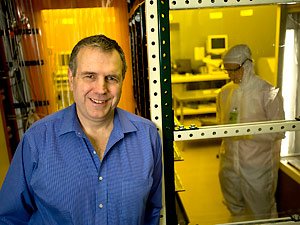2010: A space odyssey

The University seeks a new building for physics and nanotechnology
By Deane Morrison
The demands of modern research are straining the University's physical capabilities, and without new space the U's Institute of Technology (IT) risks losing ground in bedrock areas for advances in medicine, technology, and our understanding of the Universe.
Clearly, the University of Minnesota, which boasts an outstanding record in physics and nanotechnology, must do more to stay in the game.
Accordingly, the University will ask the 2010 Minnesota Legislature to fund two-thirds of a new $80 million building to house experimentalists in physics and nanotechnology.
Needed: 21st-century laboratories
The U's Tate Laboratory of Physics was designed for physics in another era, says Regents Professor of Physics Allen Goldman.
Table of contents
If built, the new building would feature the ventilation and temperature control necessary for experiments in biophysics and solid-state physics, a Class 10 clean room for biomedical applications of physics and nanotechnology, and a high bay area for constructing the large detectors needed to reveal nature's ultimate secrets.
The building would also have space for resesarch groups to meet and students to gather and help each other with problems.
To renovate Tate, its heating, ventilation, and air conditioning "would have to be recreated," he says. Tate's infrastructure could never support modern research without a complete overhaul, but it is too costly to retrofit.
For example, physics professor Paul Crowell must work around Tate's poor environmental control. In his studies of optics and low-temperature physics, he reflects lasers off precisely positioned mirrors. A temperature rise of just a half-degree Celsius can change the distance between mirrors enough to ruin his data.
And the lack of space keeps the University from adding faculty in accordance with its size and caliber.
"During this decade, we have made six offers to experimentalists that were accepted and 15 that were declined," says Ron Poling, head of the School of Physics and Astronomy. "The single biggest factor ... is the lack of competitive experimental laboratories."
Needed: Room to build
Physics professor Kenneth Heller and his U colleagues are engaged in two national projects to study neutrinos, both of which require gargantuan detectors to pick up the elusive subatomic particles. But without a high bay in Tate, they must build prototypes in a building a mile away.
"There, the loading dock can't accommodate big trucks," laments Heller. "Every time we have a delivery, we get a permit from the city, then close the street behind the building, bring in the truck and a crane, and have students carry material inside." And no deliveries are possible in slippery winter conditions.
But since they must build their next detector soon, they will rent and renovate another space outside the University at a cost of about $2.5 million.
Needed: Space to collaborate
In addition to a high bay, a new physics and nanotechnology building would house the Nanofabrication Center, which helps hundreds of clients from universities and companies across the country construct nanotechnology-based devices.
But applying nanotechnology in key areas like energy, information devices, and medicine requires shoulder-to-shoulder collaboration among engineers and professionals from biology, medicine, materials science, and physics.
"The most common example is that we need wet biology labs where you can culture human cells, bacteria, etc. next to a clean room for [device] fabrication," says Steve Campbell, director of the center. "... [W]e have inadequate square footage and equipment, and we don't even have the facilities to put equipment in."
With the collaboration a new building would allow, the University will become a stronger competitor for large federal grants in nanotechnology, which ranks second to cancer in federally sponsored research support.
